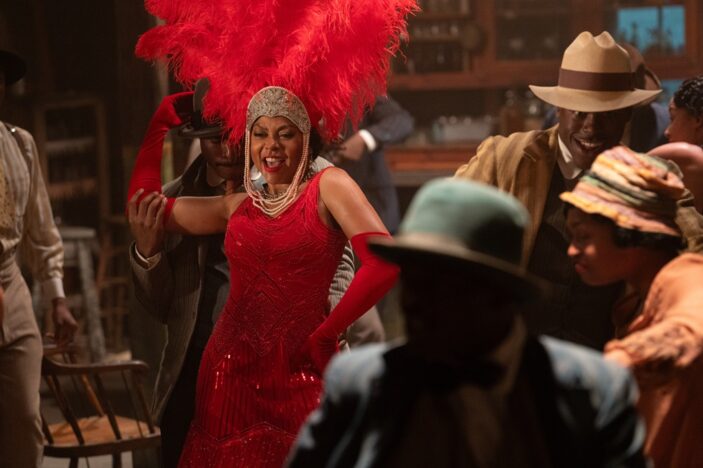
Though it’s an at-times lively and emotionally affecting tale, with a slew of stand-out performances across the board (Taraji P. Henson and the rightfully Oscar-nominated Danielle Brooks, for starters), the reimagined The Color Purple can’t help but catch itself between honouring its source material (Alice Walker‘s 1982 novel and the original 1985 film) and the Broadway musical that eventuated, resulting in an unbalanced telling that does a disservice to the importance of the story at hand.
Commencing in Georgia in 1909, Blitz Bazawule‘s story (penned here by Marcus Gardley) spans four decades, with Celie (initially portrayed by Phylicia Pearl Mpasi in her teen years) and her predominant life of tragedy at the core. Though she has had two children of her own, she exists in a largely lonely state due to her cruel father (Deon Cole) taking them away from her, leaving her without the care of a family other than her loving, devoted sister, Nettie (Halle Bailey).
As a mere child herself, there’s a disturbing current to the narrative surrounding Celie having been impregnated at least twice as a result of incestuous rape, but it’s a conversation that it’s unwilling to have, and when she’s married off to the charming, yet vile Mister (Colman Domingo), the film seems to ask us to accept such circumstances without, again, delving into dynamics or expectations. I can’t speak to this experience, but it’s a disturbing aspect that no amount of up-tempo musical numbers can overshadow.
Scared at the thought of being separated from her sister, Celie is momentarily relieved when Nettie shows up on her doorstep wanting a place to stay, though, of course, the circumstances that brought her there are expectedly devastating. Not keen on both sisters living under his roof (or his thumb), Mister drives Nettie away. Though they promise to write to each other every day, Mister’s interference keeps Celie from ever hearing from Nettie over their grown years, furthering the cycle of both emotional and physical abuse he inflicts upon the forever-kindly Celie, which ultimately sees her retreat into herself.
Though we’ve had a few toe-tapping numbers to this point, none of them feel entirely organic to how they are related to the characters’ psyches, but the film briefly corrects its course when it introduces Shug Avery (Henson, bringing all the theatrical pizazz you’d expect), Mister’s former mistress and a famed singer in her own right, who reinvigorates both the film (her solo tune “Push Da Button” is a real joy) and Celie’s spirit, leading to an unexpected romance between the two; Fantasia Barrino now portraying the grown-up Celie. This bond between the two is sadly never as realised as it deserves to be – a romance between two women of colour in the 1930s shouldn’t be a mere footnote in such a story – and it’s that seeming mentality of breezing over important issues and subject matter in favour of rushing to an uplifting culmination that proves The Color Purple‘s downfall.
We also see it in the characterisation of Sofia (Brooks, an absolute force), an early wife to Mister’s son (Corey Hawkins), who bulldozes through the film with a no-nonsense swagger (her number “Hell No!” reaffirming this) in a manner that’s wildly at odds with the timid Celie, and would have been considered something of a controversial figure given how she wildly opposed societal norms. As much noise as she makes early in the film, and a truly satisfying stance against the male figures in her life in a later set scene at the “family” dinner table, she’s sidelined for a considerable period when she engages in a public fight following the mayor’s wife calling her out to be their maid. Sofia standing up for herself and refusing to work for a wealthy white woman is an important anecdote in a story when women of colour, especially, were employed as such, but the mayor’s wife insisting on Sofia’s employ is never smoothly injected into the proceedings, and her subsequent 6-year imprisonment and eventual work for the mayor’s wife is treated with all the care of a montage inclusion, diminishing any of the emotional impact this should have.
Whilst there’s no denying that the film manages impact, and, again, I can’t (and won’t) speak to how this sits with people of colour, from a storytelling point of view The Color Purple lacks cohesion – at one point it almost forgets it’s a musical – and for a telling with such a queer throughline, it muddles its significance. The implications between Celie and Shug are too vague to warrant a deep response, and in 2024 it seems almost unforgiveable to suppress something of clear importance. Perhaps it was a creative decision to make the film more palatable to a wider audience, but as a film that’s 141 minutes long, is a musical, and dominated by performers of colour, it appeared to already have its niche carved out that omitting such an important text doesn’t make much sense.
Putting aside the film’s mishandling of representation, The Color Purple, as much as there is to love and be swept away by, never quite secures its grip on its own musicality. Though the songs and how they are presented all work fine as individual pieces, it results in an undeniably important film that, sadly, stifles its own creative flow.
![]()
![]()
![]()
![]()
![]()
TWO AND A HALF STARS (OUT OF FIVE)
The Color Purple is now screening in Australian theatres.
